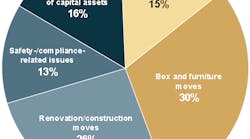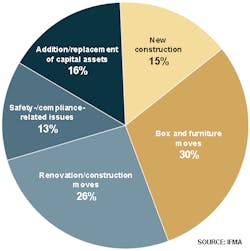There are key players who are part of almost any project team. In most cases, the team should consist of you, the building owner; an architect; an engineer; an interior designer; and a contractor. Depending on the size and scope of the project, other professionals may be called in as needed (cost estimators, landscape architects, construction managers, etc.).As the building owner, your role is to provide project definition and scope, financing/budget/scheduling information, and decision-making power. The architect brings a specific expertise to the table that unites structural, civil, mechanical, and electrical goals. "An architect's responsibility is to somehow, in a document, 'memorialize' and define the vision of the owner," says Daniel Sinnott, director of business development, Turner Construction Co., Detroit. The engineer is responsible for handling the facility's mechanical, electrical, and plumbing systems, as well as any structural analysis and design. Smart engineers will also confirm that selected systems integrate with long-term goals and standards, and verify that these systems are installed to code. The interior designer sets up plans for non-load-bearing interior construction (finishes, space planning, furnishings, fixtures, etc.). The contractor brings all of these pieces to life, with responsibility for the actual construction of the project.What Are You Waiting For?
There are various modes of thought that encircle the project team and how early it should be assembled. Depending on who you ask, there are a few different possibilities. Most professionals agree that involving everyone from the start - and keeping them on through project completion - is the best way to go. Paul Himes, president, Himes Associates Ltd., Fairfax, VA, points out that assembling the team as early as possible provides members the opportunity to play off of other members' strong points. It also increases the efficiency of the design/construction process and mitigates the possible need for design changes and/or redesign due to schedule or budget constraints, says George Daily, COO at Columbus, OH-based H.R. Gray.Hiring at project inception can also help avoid confusion and miscommunication for team members. A good example: A construction project can be on the drawing boards for years with close involvement from the architect, engineer, and you (the owner). In many cases, the contractor may be brought in at the last minute to review project documents and grasp the reasons behind the team's decisions. As with anything else, when you're too close to a project, it's easy to bypass the missing pieces of information that are needed to move the project forward. To avoid a dilemma like this, Peter Winters, senior vice president at HOK Advance Strategies, Dallas, emphasizes three instances in which the contractor should be brought in at the same time as the rest of the team: 1) if you're working with a tight schedule, 2) if you have a budget that isn't adequate to fund a project comparable to current market prices, and 3) if there is complex phasing required due to existing physical constraints and/or business-operating conditions. In these cases, bringing the contractor in early allows everyone to brainstorm and settle on the ideal solution to address these issues.Another team-building approach is what Himes refers to as the "add-as-you-go" method. "Using this method, you incrementally add team players as needed. The architect might be involved very early on and the engineer might come in later; eventually, you may hire the construction manager and start to fill out your team that way. It's a little less costly, but the team doesn't really have a chance to be cohesive or to play off of each other's strengths." Whichever way you choose to go, Himes emphasizes the need to give the team enough time to complete the project.How FMs Select Construction Providers:One firm is used for all projects,
regardless of size, type, or
scope................................17%Several qualified firms bid the
project and the lowest-cost supplier is chosen................17%Several qualified firms bid the
project and the best-value supplier
is chosen...........................50%Qualified firms are researched and
interviewed. Selection is based
upon the best fit for the
project.............................16%SOURCE: IFMAGood Things Come to Those Who Prepare
Before you start making phone calls and setting up initial interviews, there are some things you should do to get ready for the project-team search. The project begins with the needs and vision of you and your organization. If you have specific ideas about the project itself, or ways to address some of the problems that you may face along the way, now's the time to firm up those ideas and work on ways to verbalize them. Spend some time reflecting on projects you've worked on in the past. When have you been most successful and when were you disappointed? Are there things you would change about previous projects? Take tours of similar building types to figure out what you do and don't like; ask around to uncover some of the problems that were encountered in these projects and how those problems were solved. Contact other owners and colleagues who have been in charge of similar projects and ask them about the architectural/interior design/engineering firms they recommend.Winters stresses that, before assembling the project team, the owner should have a reasonable idea about the functional needs of the new building or space, as well as possible location(s). The approximate budget for the project should also be determined at this point, along with an idea about the timeline. "Also, spend some time thinking about the brand-equity image that you want this project to bring your organization," says Winters.Decide how many service firms you want to consider for this project. For architectural firms, the AIA recommends that, depending upon the size of the project, owners ask three to five organizations to submit proposals (enough to see the range available, but not so many that you'll complicate your decision). The same holds true for other service firms as well. Despite all the good things you might have heard about a firm, actively look for multiple options unless you have a superior working relationship with a firm that has done work for you in the past. And, even if they have done work for you before, a firm that was great at planning your interior office space probably won't provide top-notch results when planning your data center.Something else you should think about at this point: your decision criteria. How will you "rank" the firms? Is it going to be price, is it going to be technical qualifications, is it going to be availability? Decide and be ready to let everyone involved in the selection process know how you'll differentiate between the firms.All Firms are Not Created Equal
You probably hear the following declaration every week in terms of almost everything you do, but, as Himes states, this selection process is much more art than science. As in any relationship - whether with a vendor, a tenant, or a staff member - chemistry is always a vital issue. Occasionally, there are instances where a service firm sends in its high-level staff members for the pre-selection interview process. You may hit it off and decide to hire the firm; unfortunately, the less-experienced staff members are sent in to do the actual work, and that initial chemistry you had is lost. "Know who you're going to work with on a day-to-day basis. Whether they're architects, interior designers, or contractors, contracts are often sold by firm principals or partners. Find out who you'll be working with and make sure you're comfortable with them - that can make or break a project," says Winters.The chart below shows a breakdown of how a typical facility department's time is spent on projects in the course of a year.
You've probably spent lots of time contemplating the characteristics you look for in (and expect from) project team members, but have you spent any time thinking about what they expect from you? "This is a people business," says Himes. "You're hiring professionals - you're not buying paperclips, air-conditioning units, or elevators. If there's one piece of advice I would give to anybody who's assembling and leading project teams, it'd be to work on leadership and people skills - that's where success in a project lies." At the same time, he emphasizes the importance of listening to team members. "They're professionals; they're used to doing these projects, and they're used to doing them frequently. You don't have to follow every word, but take heed and at least listen to what they have to say." Finding that balance between being a good listener and being a good leader is crucial.
The Search is Over. Now What?
After you've waded through the sea of possible candidates and narrowed the team down to your No. 1 picks, the hard part isn't quite over. Now that you've put the team together, it's your job to keep it together. As Daily points out, communication and comfort are key to every function of the project team. "If any of the parties aren't comfortable with the other, they won't communicate." Interactive discussions are required to understand the scope of the project. If communication stops, the team is sure to fall apart. Another piece of advice from Daily: Tackle setbacks together. "When there's a problem, it needs to be considered a team problem, not an individual's problem. It should be solved as a team problem." Encourage all team members to be vocal about any questions or concerns before they become serious issues.




